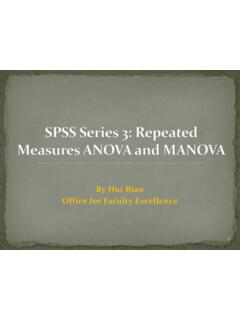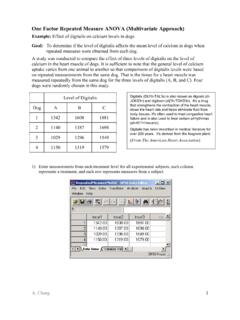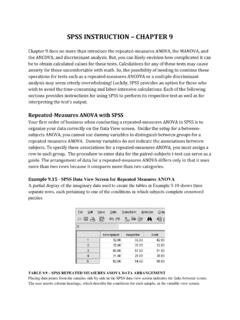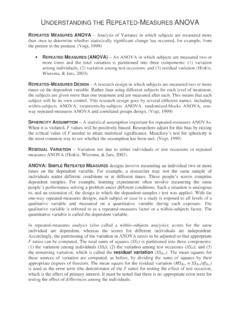Transcription of Repeated Measures Analysis of Variance - NCSS
1 NCSS Statistical Software 214-1 NCSS, LLC. All Rights Reserved. Chapter 214 Repeated Measures Analysis of Variance Introduction This procedure performs an Analysis of Variance on Repeated Measures (within-subject) designs using the general linear models approach. The experimental design may include up to three between-subject terms as well as three within-subject terms. Box s M and Mauchly s tests of the assumptions about the within-subject covariance matrices are provided. Geisser-Greenhouse, Box, and Huynh-Feldt corrected probability levels on the within-subject F tests are given along with the associated test power.
2 Repeated Measures designs are popular because they allow a subject to serve as their own control. This improves the precision of the experiment by reducing the size of the error Variance on many of the F-tests, but additional assumptions concerning the structure of the error Variance must be made. This procedure uses the general linear model (GLM) framework to perform its calculations. Identical results can be achieved by using the GLM ANOVA program. The user input of this procedure is simply the GLM panel modified to allow a more direct specification of a Repeated - Measures model.
3 We refer you to the GLM ANOVA chapter for details on the calculations and interpretations of Analysis of Variance . We will concentrate here on providing information specific to Repeated Measures Analysis . An Example This section will give an example of a Repeated - Measures experiment. An experiment was conducted to study the effects of four drugs upon reaction time to a set of tasks using five subjects. Subject Drug 1 Drug 2 Drug 3 Drug 4 1 30 28 16 34 2 14 18 10 22 3 24 20 18 30 4 38 34 20 44 5 26 28 14 30 Discussion One way of categorizing experimental designs is as between subject or within subject.
4 Examples of between-subject designs are the common factorial designs in which the experimental units (the subjects) are assigned to separate treatment conditions. Usually, this assignment is done at random. The experimenter wants to know if the variability from subject to subject is smaller than the variability from treatment to treatment. The basic assumption is that the subjects are independent from one another. Within-subject designs are those in which multiple measurements are made on the same individual.
5 Because the response to stimuli usually varies less within an individual than between individuals, the within-subject variability NCSS Statistical Software Repeated Measures Analysis of Variance 214-2 NCSS, LLC. All Rights Reserved. is usually less than (or at most equal to) the between-subject variability. Reducing the underlying variability reduces the sample size which reduces cost. Disadvantages of Within-Subjects Designs The main advantage of within-subjects designs is in the reduced variability that is achieved by controlling from differences from one subject to the next.
6 There are several disadvantages to this type of design: 1. Practice effect. In some experiments, subjects systematically improve as they practice the task being studies. In other cases, subjects may systematically get worse as the get fatigued or bored with the experimental task. Note that only the treatment administered first is immune to practice effects. Hence, experimenters often make some effort to balance the number of subjects receiving each treatment first. 2. Carryover effect. In many drug studies, it is important to wash out one drug completely before the next drug is administered.
7 Otherwise, the influence of the first drug carries over into the response to the second drug. Note that practice effects refer to a general change in response because the task is Repeated , but carryover effects refer to specific, lasting effects of a particular treatment. 3. Statistical Analysis . The statistical model that justifies the Analysis is very restrictive since the individual responses must have certain mathematical properties. Also, missing responses are much more difficult to deal with in this case.
8 4. Generalizability. Experimenters assume that differences between treatments are design independent. That is, if a completely random design was constructed, the same treatment differences would be observed. This is not always the case. Even in the face of all these disadvantages, Repeated Measures (within-subject) designs are popular in many areas of research. It is important that you recognize these problems going in, rather than learning of them later after the experiment has been conducted. Assumptions The following assumptions are made when using the F test to analyze a factorial experimental design.
9 1. The response variable is continuous. 2. The residuals follow the normal probability distribution with mean equal to zero and constant Variance . 3. The subjects are independent. Since in a within-subject design, responses coming from the same subject are not usually independent, assumption three must be modified for responses within a subject. The independence between subjects is still assumed. 4. The within-subject covariance matrices are equal for all between-subject groups. In this type of experiment, the Repeated measurements on a subject may be thought of as a multivariate response vector having a certain covariance structure.
10 This assumption states that these covariance matrices are constant from group to group. This assumption is tested by Box s M test. Of course, this assumption unnecessary in the single-group design. 5. All of the within-subject covariance matrices are circular. One way of defining circularity is that the variances of differences between any two measurements within a subject are constant. Since responses that are close together in time often have a higher correlation than those that are far apart, it is common for this assumption to be violated.










